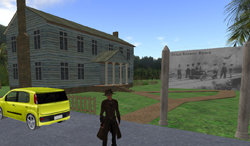Exploring Various Methods for Creating and Delivering Virtual Rosewood
Virtual Rosewood Released! - click here to explore Rosewood as it existed prior to the riot in your web browser.
A variety of delivering virtual archaeology material now exists for the new media archaeologist. In regards to Virtual Rosewood, this includes (1) a now traditional approach to virtual archaeology using expensive and time-intensive methods derived from the entertainment industry, (2) an inexpensive and quickly learnable method using Google Earth, (3) the creation of an interactive virtual museum in Second Life. I am also exploring a variety of ways to deliver this content including standard images and video, online virtual tours, and an augmented reality application. For a more thorough discussion of these methods, please see my contribution to the September 2010 issue of the African Diaspora Archaeology Newsletter.
Traditional Creation Methods
The traditional method based on the entertainment industry uses program like 3DS Max to create high quality, near photorealistic models of the structures and environs of Rosewood as it would have existed prior to the 1923 race riot. The data created using this method supplies the raw material for videos, images, and the virtual tour hosted at this site.
Virtual Rosewood Museum in Second Life
Second Life is used to deliver all sorts of 3D information via the internet. Users wishing to create content and deliver it online can do both with Second Life; one reason it has become so popular. Just follow these simple steps If you would like to view the Rosewood Virtual Museum:
1) Sign up for a free account at Second Life
2) Download the Second Life viewer here
3) Navigate to the museum by clicking here, or alternatively search for "Virtual Rosewood Museum" while logged on
Augmented Reality Rosewood
Augmented Reality (AR) involves interacting with 3D content in the physical world. Presently, most AR developers are using mobile phones to deliver their virtual content, including the rapidly growing Layar AR platform. While a pilot version of an AR Rosewood app has been developed, it most likely will not be released because of the continued threat of looting. Unfortunately, this represents a major drawback of using this technology at unprotected sites.


